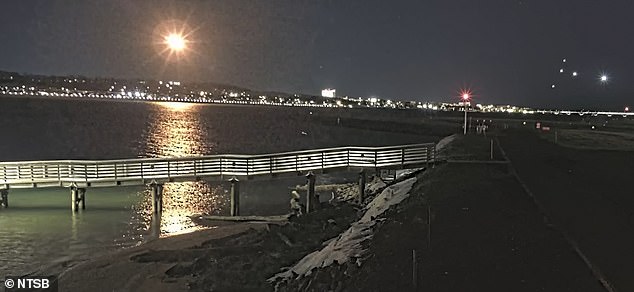A horrifying video showing the moment a US Army Black Hawk helicopter smashed into a passenger jet over Washington, DC, has been released, as investigators reveal the final words of the doomed crew.
The footage, captured by CCTV and played at the start of a three-day National Transportation Safety Board (NTSB) hearing, shows a bright flash lighting up the night sky above the Potomac River.
Seconds earlier, the military chopper had collided with American Airlines Flight 5342 as it descended into Reagan National Airport.
The Bombardier CRJ700 had been flying from Wichita, Kansas, on January 29 and was just minutes from landing when it was hit.
All 67 people on board the two aircraft were killed, including 64 passengers and crew on the jet and three helicopter crew members, marking the deadliest US airline crash in more than two decades.
The Black Hawk, operating as Priority Air Transport 25, had been on a low-level training mission and was flying back to Fort Belvoir in Virginia.
Investigators now believe the crew thought they were flying 100 feet higher than they actually were due to faulty altimeter readings.
The NTSB revealed that about three minutes before the crash, Chief Warrant Officer Andrew Eaves told co-pilot Capt. Rebecca Lobach to ‘come down for me’ and fly at 200 feet because they were currently at 300 feet.

The footage shows a bright flash lighting up the night sky above the Potomac River

The footage was captured by CCTV and played at the start of a three-day National Transportation Safety Board (NTSB) hearing

All 67 people on board the two aircraft were killed, including 63 passengers and crew on the jet and four helicopter crew members
The route down the river on which the chopper was on has a maximum altitude of 200 feet near the airport, according to the NTSB’s presentation.
Two minutes before impact, air traffic control warned them about the approaching passenger plane.
A second warning followed 90 seconds later. In both times, the helicopter crew told controllers they could see the jet and asked for ‘visual separation’ to allow them to navigate around the flight.
The controller also told the helicopter to pass behind the passenger plane, but that instruction was not heard by the crew.
Twenty seconds before the crash, Eaves said: ‘Alright, kinda come left for me ma’am, I think that’s why he’s asking.’ Lobach replied: ‘Sure.’
Eaves added: ‘We’re kinda out towards the middle.’ Lobach responded: ‘Okay fine.’
The helicopter and the jet collided at 8:48pm, causing a bright fiery flash in the night sky.
Meanwhile, in the American Airlines cockpit, the pilots used expletives when they saw the impending crash and attempted to pull the plane up just seconds before.

The American Airlines cockpit, the pilots used expletives when they saw the impending crash and attempted to pull the plane up just seconds before

The final words of the crew on board the chopper was played at the hearing
An audio excerpt of communication between air traffic controllers was also played at the hearing. It showed how they requested the jet to move to a different runway.
After the crash, NTSB investigators carried out test flights using three similar helicopters over the Potomac.
They found that downwash from the rotor blades consistently interfered with barometric altimeter readings, making it appear they were higher than they really were.
The board also heard the Black Hawk crew had been suffering from burnout, raising fresh concerns about their decision-making on the night of the crash.
Air traffic controllers have also come under scrutiny following reports that there were staffing problems at the airport on the day of the crash.
Thousands of pages of records have now been made publicly available as part of the investigations.
Aviation lawyer Bob Clifford, who is representing several of the victims’ families said there was a lot of ‘finger pointing’ and ‘no acceptance of responsibility and accountability’ during the hearing.

An audio excerpt of communication between air traffic controllers was also played at the hearing. It showed how they requested the jet to move to a different runway







